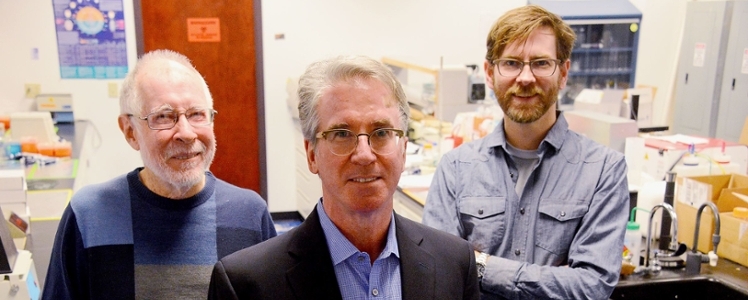Monday, February 1, 2016
Startup Sharp Edge Labs Turns Business Plan Upside Down
Drug company went from selling patented dyes to creating in-house cures
It was March or April a year ago and Marcel Bruchez probably ordered his usual, fish tacos with ice tea.At the Double Wide Grill on Carson Street, the 42-year-old Mr. Bruchez joined partners Alan Waggoner and Scott Sneddon in a casual, big-picture talk about the market and their 5-year-old company, Sharp Edge Labs Inc.
Outside the restaurant were gas pumps from the 1960s. Automotive lubrication tools were mounted on the concrete block walls inside, a backdrop for a conversation that would veer into turning a business plan inside out. By the time lunch had finished, Sharp Edge was no longer the outfit they had envisioned and a Pittsburgh drug discovery company had been born.
“This is an opportunity to do something really profound, not just business,” Mr. Bruchez remembered thinking.
Doing something really profound meant using Sharp Edge’s chemical dyes to quickly sort through hundreds of thousands of readily available drug compounds to find ones that work, ones that can fix the genetic cause of a particular disease.
Nothing like it had been done in Pittsburgh. Next up was convincing investors.
A new business plan
Pittsburgh is rarely mentioned in the same sentence with drug development hubs like Cambridge, Mass., even Philadelphia. In southwestern Pennsylvania, the number of companies finding new medications could probably be counted on one hand. Sharp Edge is among the green shoots.
The company, which was founded in 2010 by Mr. Bruchez and his 73-year-old mentor, Mr. Waggoner, has six employees and a lab on Sidney Street on the South Side. Sharp Edge’s chemical tags are made in Harmar Township.
Like all startups, raising capital has been the focus. The small company raised $1.6 million in investments since its founding and is gearing up for a $2.5 million fundraising round.
Meanwhile, the number of diseases with confirmed genetic links grows weekly: more than than one in four new medications approved by the Food and Drug Administration last year were targeted to the individual patient. And Sharp Edge has ridden the tide, receiving grants from the Michael J. Fox Foundation and Alzheimer Drug Discovery Foundation to develop tools for the identification of specific strains of Parkinson’s disease and dementia.
But Sharp Edge’s plans were not always so big.
First idea: sell dyes to other companies
The company’s business model out of the box went like this: make money by selling chemical dyes and related lab services to Big Pharma. The company wasn’t yet making money when they shifted direction.
Now, using its chemical dyes, Sharp Edge wants to bring the drug making capability in house. Here’s how: Think of proteins as cell machinery, reading DNA blueprints to build things. Gene-related diseases stop proteins from getting to the right place in the cell, but Sharp Edge markers light up when proteins arrive at their proper destination.
Sharp Edge’s products glow fluorescent greens and reds under a microscope, shadowing the movement of proteins inside human cells in real time the way radio frequency identification tags sound an alarm when a shoplifter leaves the store. These tiny movements are key to finding out whether a drug compound can correct a genetic defect to fight disease.
That’s critical at a time when prescription medicine is being transformed from a one-size-fits-all approach to a precision approach, where drugs are tailored to the patient’s individual genetic defect, said Dr. David Roth, director of Penn Medicine Precision Medicine Program in Philadelphia.
“What makes this revolutionary is there are precise molecular therapies, in cases where we know the genetic alteration, and that really opens the door to individualized therapies,” he said. “You only give the drug that’s going to be effective to that particular defect.”
A shift in thinking
What Mr. Bruchez and Mr. Waggoner couldn’t see when founding the company was how the decision to hire Mr. Sneddon would prove providential.
Mr. Sneddon, 54, received his Ph.D. at CMU in chemistry and biology and worked in Pfizer Central Research as part of the new leads drug discovery group.
What he brought to lunch that day at the Double Wide was a Big Pharma understanding of protein trafficking, a normal part of everyday cell workings that goes haywire when disease strikes. Mr. Sneddon put words to the thoughts he’d been turning over in his head for weeks: why couldn’t Sharp Edge use its molecular tracking technology to identify new drugs to treat diseases rather than selling their products’ capabilities to customers?
“Oh, my God, the actual cause of the disease is a trafficking issue,” Mr. Sneddon remembered thinking. “And if you fix the trafficking defect, you will correct the disease.”
Sharp Edge would begin mining for gold instead of just selling the picks and shovels, using technologic innovations from years of academic research by Mr. Waggoner and Mr. Bruchez.
A royalty generator
In the 1980s, Mr. Waggoner pioneered chemical dye technology that now is used by scientists worldwide. Mr. Waggoner, a professor of biological sciences at CMU, received his Ph.D. in chemistry from the University of Oregon and did postdoctoral work at Yale University before joining CMU’s faculty in 1982.
Mr. Waggoner, who has more than 15 patents, left CMU in 1992 to become vice chairman of Biological Detection Systems Inc., a Pittsburgh startup that sold microscopic imaging systems and fluorescent labeling reagents developed at the university.
Biological Detection was sold in 1994 to Amersham PLC, which enjoyed robust sales of those products. Mr. Waggoner returned to CMU as a faculty member in 2000 while the university held onto the intellectual property license to the chemical tags and related products.
Amersham’s product sales are among the biggest sources of royalty revenue for the university, CMU spokesman Ken Walters said. He declined to disclose figures.
”There’s no guarantee in biotech,“ said Mr. Waggoner. ”But sometimes you get lucky.“
More important than luck since the BDS years, Mr. Waggoner was able to develop smart chemical dyes that track protein movement like those tags that are attached to clothing to stop shoplifters. These new smart dyes were licensed from CMU to form the basis of Sharp Edge.
Boyish looking Mr. Bruchez, sometimes mistaken for a graduate student, brought scientific and entrepreneurial depth. He received a Ph.D. in chemistry from the University of California, Berkeley, and then founded Quantum Dot, a cell labeling technology. He and Mr. Waggoner became a team at CMU when Mr. Waggoner invited him to join the faculty in 2006.
The final ingredient needed for the Sharp Edge relaunch was the latest screening technology developed and licensed from CMU, a culmination of Mr. Waggoner’s research since the 1980s.
Conventional drug development methods are slow and cumbersome, which limits effectiveness testing to just five to 10 compounds a day. Sharp Edge offered a key advantage to this task — speed.
By adding readily available high-speed robotics, Sharp Edge’s process can increase the speed of screening various drug compounds by 1,000-fold, Mr. Sneddon said, creating the opportunity to tap chemical compound libraries in the search for potential cures. Cataloged drug compound storehouses are readily available commercially.
Facing the investors
Sharp Edge’s change in direction created a virtual medication pipeline. Still, investors had to be convinced. Enter Sewickley-based Newlin Investment Co. LLC.
Convinced of Sharp Edge’s potential, Newlin led a $600,000 funding round last year. Now Mr. Sneddon had to explain that the company had completely changed course.
Mr. Sneddon said he was anxious before the board meeting where he would outline the new direction.
But Chairman Bill Newlin had seen other newly minted companies struggle with similar issues, so he was ready for the news. Startup companies with a revolutionary technology sometimes have to feel their way around for a while before settling on a business model, Mr. Newlin said.
“Any time you have a potentially technologically disruptive technology, you have to ask, is there any better model that we could go after to make us an even more successful company,” said Mr. Newlin, 75, a veteran early stage investor. “If we can do what we believe we can, then this is groundbreaking. If we’re right, we have the potential to solve a lot of human misery.”
The small South Side company is now focusing on developing medications for diseases that can have a genetic cause: cystic fibrosis, Parkinson’s disease and Alzheimer’s disease.
Clinical trials for drugs identified by Sharp Edge are expected within two years, Mr. Sneddon said. Read More»
By: Kris B. Mamula

